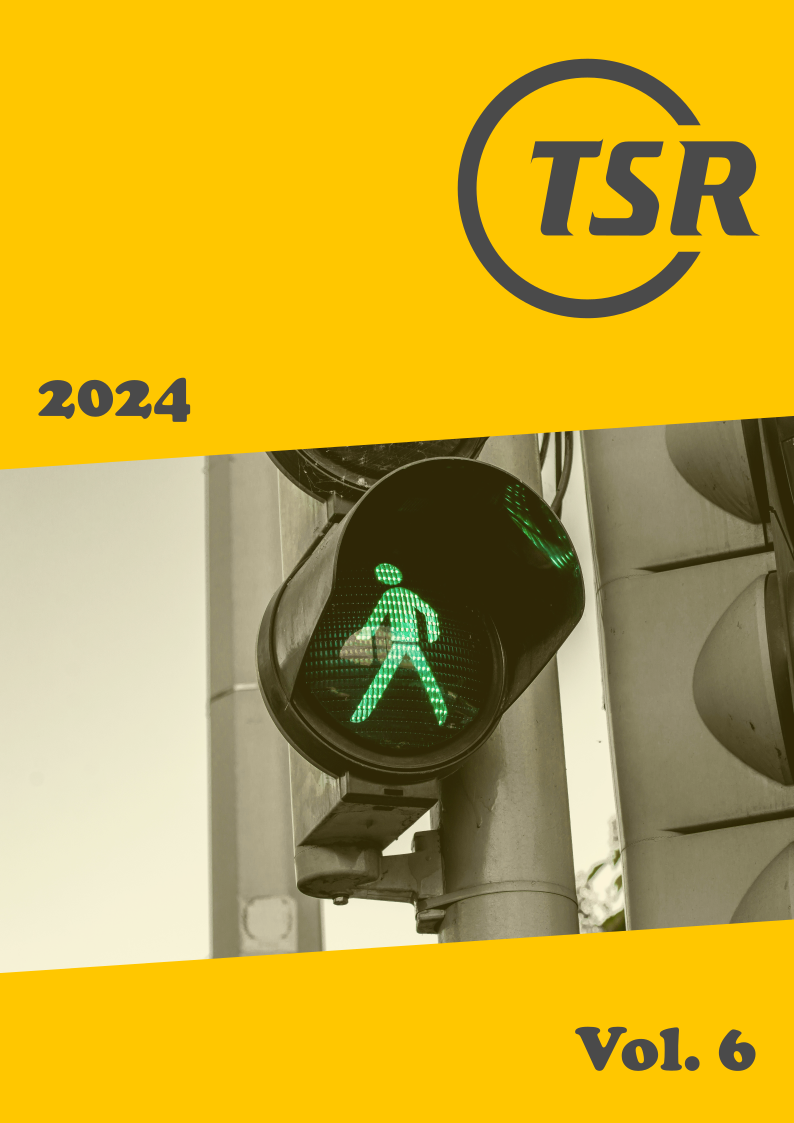Does training improve users' mental models about adaptive cruise control?
DOI:
https://doi.org/10.55329/aqze5695Keywords:
adaptive cruise control (ACC), advanced driver assistance systems (ADAS), driver training, mental modelsAbstract
While Advanced Driver Assistance Systems (ADAS) promise safety benefits to drivers, there is evidence to suggest that drivers are unaware or uninformed about their vehicles’ systems and thus have poor mental models about the systems. Previous studies suggest that training improves drivers’ mental models, although some studies report limited impacts. This study investigated the relationship between training and drivers’ mental models about Adaptive Cruise Control (ACC), compared the impact of two different training approaches on drivers’ mental models, and examined the relationship between driver knowledge and trust regarding ADAS technologies. This study was conducted online, and participants were randomly and equally assigned to one of three training groups – owner’s manual (text-based); state diagram visualization; or sham (control). Surveys measured their trust and mental models about ACC before and after training. The results found that the text-based group outperformed the visualization group and the control group in terms of post-training overall mental model scores, but these differences were not statistically significant. No correlation between post-training mental model scores and overall trust scores was found. This study provides evidence that training improves users’ mental models about technology and finds that different training platforms or paradigms may affect learning differently.
Downloads
References
Beggiato, M., J. F. Krems (2013), 'The evolution of mental model, trust and acceptance of adaptive cruise control in relation to initial information', Transportation Research Part F: Traffic Psychology and Behaviour, 18, 47–57. DOI: https://doi.org/10.1016/j.trf.2012.12.006
DeGuzman, C. A., B. Donmez (2022), 'Drivers don't need to learn all ADAS limitations: A comparison of limitation-focused and responsibility-focused training approaches', Accident Analysis & Prevention, 178, 106871. DOI: https://doi.org/10.1016/j.aap.2022.106871
Dickie, D. A., L. N. Boyle (2009), 'Drivers’ understanding of adaptive cruise control limitations', Proceedings from Human Factors and Ergonomics Society Annual Meeting, 53(23), 1806–1810. DOI: https://doi.org/10.1518/107118109X12524444082439
Divekar, G., A. K. Pradhan, K. M. Masserang, I. Reagan, A. Pollatsek, D. L. Fisher (2013), 'A simulator evaluation of the effects of attention maintenance training on glance distributions of younger novice drivers inside and outside the vehicle', Transportation Research Part F: Traffic Psychology and Behaviour, 20, 154–169. DOI: https://doi.org/10.1016/j.trf.2013.07.004
Durso, F. T., S. D. Gronlund (1999), 'Situation awareness', in Durso, F. T. (ed.), Handbook of applied cognition, (New York, US: Wiley) pp. 283-314.
Forster, Y., S. Hergeth, F. Naujoks, J. Krems, A. Keinath (2019), 'User education in automated driving: Owner’s manual and interactive tutorial support mental model formation and human-automation interaction', Information, 10, 143. DOI: https://doi.org/10.3390/info10040143
Garavan, T. N. (1997), 'Training, development, education and learning: different or the same?', Journal of European Industrial Training, 21(2), 39–50. DOI: https://doi.org/10.1108/03090599710161711
Gaspar, J. G., C. Carney, E. Shull, W. Horrey (2020), 'The impact of driver's mental models of advanced vehicle technologies on safety and performance', AAA Foundation for Traffic Safety.
Horswill, M. S., E. K. Falconer, N. A. Pachana, MWetton, A. Hill (2015), 'The longer-term effects of a brief hazard perception training intervention in older drivers', Psychology and Aging, 30(1), 62–67. DOI: https://doi.org/10.1037/a0038671
Jenness, J. W., N. D. Lerner, S. Mazor, J. S. Osberg, B. C. Tefft (2008), 'Use of advanced in-vehicle technology by young and older early adopters. Survey results on navigation systems', National Highway Traffic Safety Administration (NHTSA), DOT HS 810 828. DOI: https://doi.org/10.1037/e622262011-001
Jian, J.-Y., A. M. Bisantz, C. G. Drury (2000), 'Foundations for an empirically determined scale of trust in automated systems', International Journal of Cognitive Ergonomics, 4(1), 53–71, AFRL-HE-WP-TR-2000-0102. DOI: https://doi.org/10.1207/S15327566IJCE0401_04
Kassambara, A. (2024), 'rstatix: Pipe-friendly framework for basic statistical tests'.
Kazi, T. A., N. A. Stanton, M. S. Young, D. A. Harrison (2017), 'Assessing drivers' level of trust in Adaptive Cruise Control and their conceptual models of the system: implications for system design', in Dorn, L. (ed.), Driver Behaviour and Training, (London, UK: Routledge) 2, pp. 133-142.
Kidd, D. G., J. B. Cicchino, I. J. Reagan, L. B. Kerfoot (2017), 'Driver trust in five driver assistance technologies following real-world use in four production vehicles', Traffic Injury Prevention, 18(sup1), S44–S50. DOI: https://doi.org/10.1080/15389588.2017.1297532
Klašnja-Milicevic, A., B. Vesin, M. Ivanovic, Z. Budimac, L. C. Jain (2016), E-Learning Systems: Intelligent Techniques for Personalization, (New York, US: Springer). 112.
Koc-Januchta, M., T. Höffler, G.-B. Thoma, H. Prechtl, D. Leutner (2017), 'Visualizers versus verbalizers: Effects of cognitive style on learning with texts and pictures—An eye- tracking study', Computers in Human Behavior, 68, 170–179. DOI: https://doi.org/10.1016/j.chb.2016.11.028
Koustanaï, A., V. Cavallo, P. Delhomme, A. Mas (2012), 'Simulator training with a forward collision warning system: Effects on driver-system interactions and driver trust', Human Factors, 54(5), 709–721. DOI: https://doi.org/10.1177/0018720812441796
Larsson, A. F. L. (2012), 'Driver usage and understanding of adaptive cruise control', Applied Ergonomics, 43(3), 501–506. DOI: https://doi.org/10.1016/j.apergo.2011.08.005
Lee, J. D., K. A. See (2004), 'Trust in automation: Designing for appropriate reliance', Human Factors, 46(1), 50–80. DOI: https://doi.org/10.1518/hfes.46.1.50.30392
McDonald, A. B., D. V. McGehee, S. T. Chrysler, N. M. Askelson, L. S. Angell, B. D. Seppelt (2016), 'National survey identifying gaps in consumer knowledge of advanced vehicle safety systems', Transportation Research Record, 2559(1), 1–6. DOI: https://doi.org/10.3141/2559-01
McDonald, A., C. Carney, D. V. McGehee (2018), 'Vehicle owners’ experiences with and reactions to advanced driver assistance systems', AAA Foundation for Traffic Safety, 202-638-5944.
Mehlenbacher, B., M. S. Wogalter, K. R. Laughery (2002), 'On the reading of product owner's manuals: Perceptions and product complexity', Proceedings of the Human Factors and Ergonomics Society Annual Meeting, 46(6), 730–734. DOI: https://doi.org/10.1177/154193120204600610
Mueller, A. S., J. B. Cicchino, J. Singer, J. W. Jenness (2020), 'Effects of training and display content on Level 2 driving automation interface usability', Transportation Research Part F: Traffic Psychology and Behaviour, 69, 61–71. DOI: https://doi.org/10.1016/j.trf.2019.12.010
Muttart, J. W. (2013), 'Identifying hazard mitigation behaviors that lead to differences in the crash risk between experienced and novice drivers', PhD thesis, University of Massachusetts Amherst, US.
NHTSA, (2017), 'Automated Driving Systems 2.0: A vision for safety', National Highway Traffic Safety Administration, DOT HS 812 442.
Noble, A. M., S. G. Klauer, Z. R. Doerzaph, M. P. Manser (2019), 'Driver training for automated vehicle technology—knowledge, behaviors, and perceived familiarity', Proceedings of the Human Factors and Ergonomics Society Annual Meeting, 63(1), 2110–2114. DOI: https://doi.org/10.1177/1071181319631249
NSC, (2024), 'Lane departure warning: MyCarDoesWhat?', National Safety Council.
Pai, G., A. P. Hungund, S. Widrow, J. Radadiya, A. K. Pradhan (2021), 'Users' perception of training approaches for Advanced Driver Assistance Systems (ADAS)', Proceedings of the Human Factors and Ergonomics Society Annual Meeting, 65(1), 279–283. DOI: https://doi.org/10.1177/1071181321651266
Paivio, A. (2014), Mind and its evolution: A dual coding theoretical approach, (New York, US: Psychology Press). DOI: https://doi.org/10.4324/9781315785233
Payre, W., J. Cestac, N.-T. Dang, F. Vienne, P. Delhomme (2017), 'Impact of training and in-vehicle task performance on manual control recovery in an automated car', Transportation Research Part F: Traffic Psychology and Behaviour, 46, 216–227. DOI: https://doi.org/10.1016/j.trf.2017.02.001
Plass, J. L., D. M. Chun, R. E. Mayer, D. Leutner (1998), 'Supporting visual and verbal learning preferences in a second-language multimedia learning environment', Journal of Educational Psychology, 90(1), 25–36. DOI: https://doi.org/10.1037//0022-0663.90.1.25
Pradhan, A. K., G. Divekar, K. Masserang, M. Romoser, T. Zafian, R. D. Blomberg, F. D. Thomas, I. Reagan, M. Knodler, A. Pollatsek, D. L. Fisher (2011), 'The effects of focused attention training on the duration of novice drivers’ glances inside the vehicle', Ergonomics, 54(10), 917–931. DOI: https://doi.org/10.1080/00140139.2011.607245
Pradhan, A. K., D. L. Fisher, A. Pollatsek (2005), 'The effects of PC-based training on novice drivers’ risk awareness in a driving simulator', 3rd International Driving Symposium on Human Factors in Driver Assessment, Training, and Vehicle Design, Rockland, US, 27–30 June, pp. 81-87. DOI: https://doi.org/10.17077/drivingassessment.1146
Pradhan, A. K., G. Pai, M. A. Knodler, C. Fitzpatrick, W. J. Horrey (2021), 'Driver’s mental models of advanced vehicle technologies: A proposed framework for identifying and predicting operator errors', AAA Foundation for Traffic Safety.
Pradhan, A. K., G. Pai, J. Radadiya, M. A. Knodler, C. Fitzpatrick, W. J. Horrey (2020), 'Proposed framework for identifying and predicting operator errors when using advanced vehicle technologies', Transportation Research Record, 2674(10), 105–113. DOI: https://doi.org/10.1177/0361198120938778
Pruim, R., D. T. Kaplan, N. J. Horton (2017), 'The mosaic package: Helping students to think with data using R', The R Journal, 9(1), 77–102. DOI: https://doi.org/10.32614/RJ-2017-024
Sadoski, M., V. L. Willson (2006), 'Effects of a theoretically based large-scale reading intervention in a multicultural urban school district', American Educational Research Journal, 43(1), 137–154. DOI: https://doi.org/10.3102/00028312043001137
SAE, (2021), 'Taxonomy and definitions for terms related to driving automation systems for on-road motor vehicles', SAE, J3016_202104.
Sarter, N. B., D. D. Woods (1995), 'How in the world did we ever get into that mode? Mode error and awareness in supervisory control', Human Factors, 37(1), 5–19. DOI: https://doi.org/10.1518/001872095779049516
Schacter, D. L. (1999), 'The seven sins of memory: Insights from psychology and cognitive neuroscience', American Psychologist, 54(3), 182–203. DOI: https://doi.org/10.1037//0003-066X.54.3.182
Singer, J., J. W. Jenness (2020), 'Impact of information on consumer understanding of a partially automated driving system', AAA Foundation for Traffic Safety.
Singh, S. (2015), 'Critical reasons for crashes investigated in the National Motor Vehicle Crash Causation Survey', National Highway Traffic Safety Administration, DOT HS 812 115.
Stanton, N. A., P. M. Salmon (2009), 'Human error taxonomies applied to driving: A generic driver error taxonomy and its implications for intelligent transport systems', Safety Science, 47(2), 227–237. DOI: https://doi.org/10.1016/j.ssci.2008.03.006
Stern, E. (2017), 'Individual differences in the learning potential of human beings', npj Science Learn, 2, 2. DOI: https://doi.org/10.1038/s41539-016-0003-0
Subaru, (2020), 'Outback owner’s manual', Subaru Corporation.
Tabbers, H. K., R. L. Martens, J. J. V. Merriënboer (2004), 'Multimedia instructions and cognitive load theory: Effects of modality and cueing', British Journal of Educational Psychology, 74(1), 71–81. DOI: https://doi.org/10.1348/000709904322848824
Toyota, (2021), 'Toyota 2021 RAV4 prime owner's manual', Toyota Motor Corporation.
Victor, T. W., E. Tivesten, P. Gustavsson, J. Johansson, F. Sangberg, M. Ljung Aust (2018), 'Automation expectation mismatch: Incorrect prediction despite eyes on threat and hands on wheel', Human Factors, 60(8), 1095–1116. DOI: https://doi.org/10.1177/0018720818788164
Vlakveld, W. P. (2014), 'A comparative study of two desktop hazard perception tasks suitable for mass testing in which scores are not based on response latencies', Transportation Research Part F: Traffic Psychology and Behaviour, 22, 218–231. DOI: https://doi.org/10.1016/j.trf.2013.12.013
Walker, G. H., N. A. Stanton, T. A. Kazi, P. M. Salmon, D. P. Jenkins (2009), 'Does advanced driver training improve situational awareness?', Applied Ergonomics, 40(4), 678–687. DOI: https://doi.org/10.1016/j.apergo.2008.06.002
Wickens, C. D., J. G. Hollands, S. Banbury, R. Parasuraman (2015), Engineering Psychology and Human Performance, (Hove, UK: Psychology Press). DOI: https://doi.org/10.4324/9781315665177
Wickham, H. (2016), ggplot2: Elegant Graphics for Data Analysis, (New York, US: Springer). DOI: https://doi.org/10.1007/978-3-319-24277-4_9
Wilson, K. M., S. Yang, T. Roady, J. Kuo, M. G. Lenné (2020), 'Driver trust & mode confusion in an on-road study of level-2 automated vehicle technology', Safety Science, 130, 104845. DOI: https://doi.org/10.1016/j.ssci.2020.104845
Yahoodik, S., Y. Yamani (2021), 'Effectiveness of risk awareness perception training in dynamic simulator scenarios involving salient distractors', Transportation Research Part F: Traffic Psychology and Behaviour, 81, 295–305. DOI: https://doi.org/10.1016/j.trf.2021.06.009
Yamani, Y., S. Samuel, M. A. Knodler, D. L. Fisher (2016), 'Evaluation of the effectiveness of a multi-skill program for training younger drivers on higher cognitive skills', Applied Ergonomics, 52, 135–141. DOI: https://doi.org/10.1016/j.apergo.2015.07.005
Zahabi, M., A. M. A. Razak, R. K. Mehta, M. Manser (2021), 'Effect of advanced driver-assistance system trainings on driver workload, knowledge, and trust', Transportation Research Part F: Traffic Psychology and Behaviour, 76, 309–320. DOI: https://doi.org/10.1016/j.trf.2020.12.003
Zopf, R., C. M. Giabbiconi, T. Gruber, M. M. Müller (2004), 'Attentional modulation of the human somatosensory evoked potential in a trial-by-trial spatial cueing and sustained spatial attention task measured with high density 128 channels EEG', Cognitive Brain Research, 20(3), 491–509. DOI: https://doi.org/10.1016/j.cogbrainres.2004.02.014
Published
How to Cite
Issue
Section
License
Copyright (c) 2024 Apoorva Pramod Hungund, Ganesh Pai, Anuj K. Pradhan

This work is licensed under a Creative Commons Attribution 4.0 International License.










